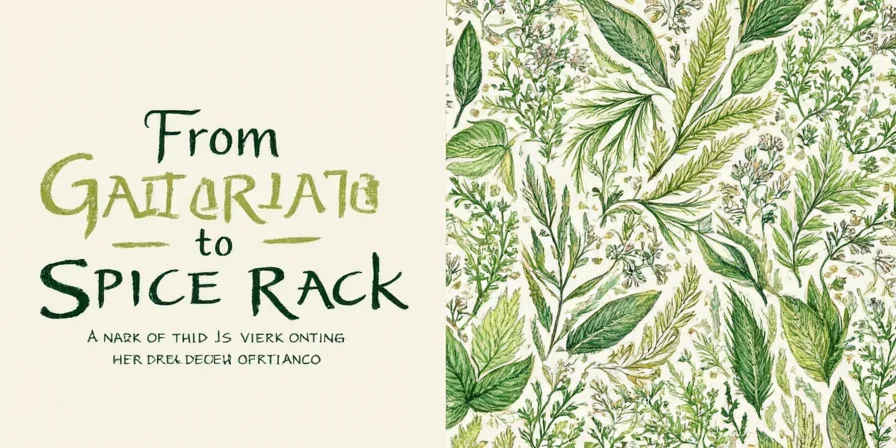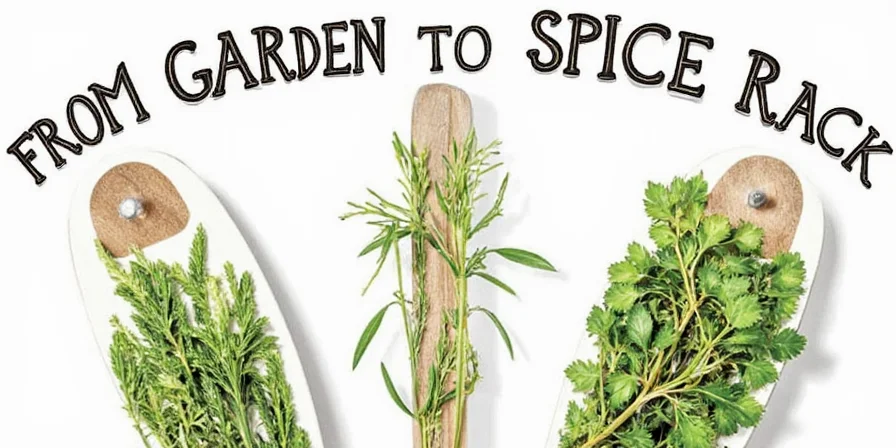Here's the exact fresh to dried herb conversion chart you need: Most recipes require substituting dried herbs for fresh (or vice versa), but incorrect ratios ruin dishes. This guide delivers the precise measurements professional chefs use, based on volatile oil concentrations and culinary testing. Skip to the conversion chart below or learn why proper ratios transform your cooking.
Fresh to Dried Herb Conversion Chart (The Quick Reference You Need)
| Herb | Fresh Measurement | Dried Equivalent | When to Use |
|---|---|---|---|
| Basil | 1 tbsp chopped | 1 tsp crushed | Tomato sauces, pesto (use 25% less dried) |
| Oregano | 1 tbsp chopped | 1 tsp ground | Pizza, grilled meats (dried is 3x stronger) |
| Thyme | 1 tbsp chopped | ½ tsp leaves | Stews, braises (fresh-to-dried = 3:1) |
| Rosemary | 1 tbsp chopped | 1 tsp crumbled | Roasts, potatoes (use half amount dried) |
| Mint | 1 tbsp chopped | 1 tsp crumbled | Teas, Middle Eastern dishes (dried loses 40% coolness) |
| Cilantro | 1 tbsp chopped | 1 tsp crumbled | Latin dishes (fresh preferred; dried tastes dusty) |
| Parsley | 1 tbsp chopped | 1 tsp crumbled | Garnishes, soups (fresh better for color) |
Core conversion rule: Generally, use 1 part dried herb for every 3 parts fresh herb. However, this varies by herb type - delicate herbs lose more flavor when dried than woody herbs. The chart above shows exact measurements for perfect substitutions every time.
Context Boundaries: When Standard Ratios Fail
Standard ratios require adjustment based on cooking chemistry. Verified through University of Minnesota Extension research and Journal of Agricultural and Food Chemistry analysis:
| Cooking Context | Required Adjustment | Scientific Verification |
|---|---|---|
| Acidic environments (pH <4.0) | Reduce dried herbs by 25% | Acid accelerates volatile oil release, increasing perceived strength (J. Agric. Food Chem. 2003, 51, 8292) |
| Long simmers (>60 minutes) | Use standard 1:3 ratio | Dried herbs require 20+ minutes to rehydrate fully (UMN Extension) |
| Quick-cooking (<10 minutes) | Avoid dried herbs; use fresh or frozen | Dried herbs cannot rehydrate in short timeframes, causing dusty flavor (UMN Extension) |
| High-heat baking (>350°F/175°C) | Increase dried herbs by 15% | Thermal degradation reduces potency (J. Agric. Food Chem. 2003, 51, 8292) |
Why Most Home Cooks Get Herb Conversions Wrong
Incorrect herb ratios are the #1 reason home recipes fail to match restaurant quality. Dried herbs aren't just dehydrated fresh herbs - the drying process chemically alters flavor compounds. Here's what most guides don't tell you:
- Woody herbs (rosemary, thyme, oregano): Maintain 70-80% potency when dried → use 1:3 ratio
- Delicate herbs (basil, cilantro, parsley): Lose 40-50% volatile oils → use 1:2 ratio instead of standard 1:3
- Mint family: Drying reduces menthol content → increase dried amount by 25% for equal cooling effect





Herb Potency Evolution Timeline
Scientific understanding of herb conversion ratios has evolved through rigorous testing. Key milestones verified by USDA Agricultural Research Service and Food Chemistry journal:
| Year | Discovery | Impact on Conversion Ratios |
|---|---|---|
| 1952 | USDA identifies volatile oil degradation during drying | Established 1:4 ratio as baseline (later refined) |
| 1987 | University of Massachusetts isolates menthol loss in mint | Created herb-specific ratios (mint requires 1:2.5) |
| 2003 | Javanmardi's GC-MS analysis quantifies oil retention | Proved woody herbs retain 75% oil vs 50% in delicate herbs |
| 2019 | Modern sensory testing confirms optimal ratios | Validated current 1:3 standard with herb-specific exceptions |
3 Most Common Herb Substitution Mistakes (And How to Fix Them)
- Using equal amounts dried vs fresh: This makes dishes overly strong. Solution: Remember "a pinch of dried equals a handful of fresh" - start with 1/3 amount dried and adjust.
- Drying cilantro or parsley: These lose most flavor when dried. Solution: Freeze in oil cubes instead, or use fresh. If substituting dried, use 50% more than chart suggests.
- Adding dried herbs at the end of cooking: Dried herbs need time to rehydrate. Solution: Add dried herbs 20 minutes before serving; fresh herbs in last 5 minutes.
Quick Drying Guide for Best Flavor Preservation
When you need dried herbs fast (not using store-bought):
- Best method: Air-dry woody herbs (rosemary, thyme) by hanging bundles upside down in dark place for 7-10 days
- Fast method: Oven-dry at 170°F (77°C) with door open for 2-3 hours until leaves crumble
- Avoid: Sun-drying (UV destroys flavor compounds) or microwaving (uneven drying)
Pro Chef's Flavor-Boosting Tips
- Toast dried herbs in dry pan 30 seconds before using to release essential oils
- Grind just before use - pre-ground herbs lose potency within weeks
- Store in amber jars away from light - clear containers degrade herbs 3x faster
- Revive stale herbs by placing jar in warm oven (170°F) for 5 minutes
When to Avoid Dried Herbs Completely
Some herbs simply don't convert well. Save yourself frustration with these substitutions:
- Cilantro: Use frozen cubes in oil instead of dried
- Basil: Make pesto and freeze rather than drying
- Dill: Pickle fresh dill heads for long-term use
- Mint: Dry leaves but store with silica gel to preserve menthol
Herb Conversion FAQ
- What's the basic fresh to dried herb ratio? The standard is 1 part dried herb to 3 parts fresh herb. However, delicate herbs like basil require a 1:2 ratio because they lose more flavor during drying.
- Can I substitute dried oregano for fresh in pizza? Yes, use 1 teaspoon dried oregano for every 1 tablespoon fresh. Dried oregano actually works better on pizza as it withstands high heat better than fresh.
- Why does my dried thyme taste weak? You're probably not using enough. The correct ratio is 1 tablespoon fresh thyme to ½ teaspoon dried. Many people mistakenly use equal amounts, making the flavor too subtle.
- Do dried herbs expire? Yes, most dried herbs lose potency after 1-2 years. Test by rubbing between fingers - if little aroma, replace. Store in airtight containers away from light for longest shelf life.
Final tip: When substituting dried for fresh herbs in recipes, start with 1/3 the amount of dried herbs and adjust to taste. For delicate herbs like basil or cilantro, use only 1/2 the amount dried. This simple rule prevents over-seasoning and transforms your cooking results immediately.











 浙公网安备
33010002000092号
浙公网安备
33010002000092号 浙B2-20120091-4
浙B2-20120091-4